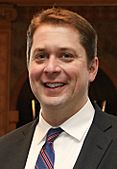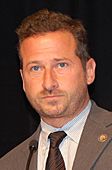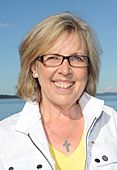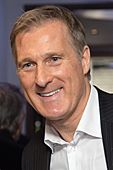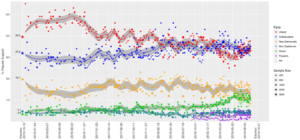2019 Canadian federal election facts for kids
|
|||||||||||||||||||||||||||||||||||||||||||||||||||||||||||||||||||||||||||||||||||||||||||||||||||||
|
|
|||||||||||||||||||||||||||||||||||||||||||||||||||||||||||||||||||||||||||||||||||||||||||||||||||||
|
All 338 seats in the House of Commons 170 seats needed for a majority |
|||||||||||||||||||||||||||||||||||||||||||||||||||||||||||||||||||||||||||||||||||||||||||||||||||||
|---|---|---|---|---|---|---|---|---|---|---|---|---|---|---|---|---|---|---|---|---|---|---|---|---|---|---|---|---|---|---|---|---|---|---|---|---|---|---|---|---|---|---|---|---|---|---|---|---|---|---|---|---|---|---|---|---|---|---|---|---|---|---|---|---|---|---|---|---|---|---|---|---|---|---|---|---|---|---|---|---|---|---|---|---|---|---|---|---|---|---|---|---|---|---|---|---|---|---|---|---|---|
| Opinion polls | |||||||||||||||||||||||||||||||||||||||||||||||||||||||||||||||||||||||||||||||||||||||||||||||||||||
| Turnout | 65.95% ( |
||||||||||||||||||||||||||||||||||||||||||||||||||||||||||||||||||||||||||||||||||||||||||||||||||||
|
|||||||||||||||||||||||||||||||||||||||||||||||||||||||||||||||||||||||||||||||||||||||||||||||||||||
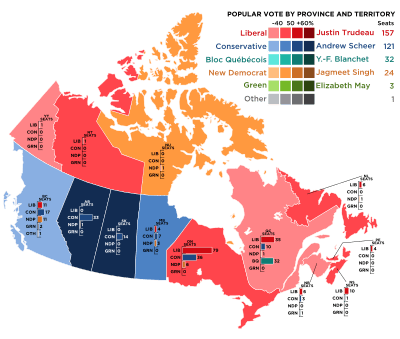
Popular vote by province, with graphs indicating the number of seats won within that province. (Because seats are awarded by the popular vote in each riding, the provincial popular vote does not necessarily translate to more seats.)
|
|||||||||||||||||||||||||||||||||||||||||||||||||||||||||||||||||||||||||||||||||||||||||||||||||||||
|
|||||||||||||||||||||||||||||||||||||||||||||||||||||||||||||||||||||||||||||||||||||||||||||||||||||
The 2019 Canadian federal election (also known as the 43rd Canadian general election) was a big event where people across Canada voted for their leaders. It took place on October 21, 2019. In this election, Canadians chose who would represent them in the House of Commons. This is an important part of Canada's government.
Canadians vote for a Member of Parliament (MP) to represent their local area, called a riding. The political party that wins the most seats usually forms the government. To form a majority government, a party needs to win at least 170 out of the 338 seats. If no party wins a majority, it's called a minority government.
Contents
Election Results
The 2019 election had some interesting results. The Liberal Party, led by Justin Trudeau, won the most seats. However, they did not win enough seats to form a majority government. This meant they had to form a minority government.
Who Won the Most Seats?
- The Liberal Party won 157 seats. This was fewer seats than they had before the election.
- The Conservative Party of Canada|Conservative Party, led by Andrew Scheer, won 121 seats. They actually won the most individual votes across Canada.
- The Bloc Québécois, led by Yves-François Blanchet, won 32 seats. This was a big increase for them.
- The New Democratic Party|New Democratic Party (NDP), led by Jagmeet Singh, won 24 seats.
- The Green Party of Canada|Green Party, led by Elizabeth May, won 3 seats.
- One independent candidate also won a seat.
What is a Minority Government?
When a party forms a minority government, it means they don't have enough seats to pass laws on their own. They need support from other parties to get things done. This often means they have to work together and compromise with other parties in the House of Commons.
Understanding Opinion Polls
Before an election, groups often ask people who they plan to vote for. This is called opinion polling. These polls try to guess what the election results might be. They help us see how popular different parties and leaders are.
Polls are like a snapshot of public opinion at a certain time. They can change as the election gets closer. The image above shows how opinions changed during the time leading up to the 2019 election.
Images for kids
See also
 In Spanish: Elecciones federales de Canadá de 2019 para niños
In Spanish: Elecciones federales de Canadá de 2019 para niños



